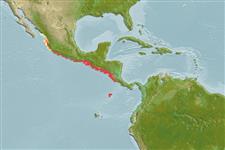>
Eupercaria/misc (Various families in series Eupercaria) >
Labridae (Wrasses)
Etymology: Polylepion: Derived from the Greek adjective 'polys' for many and the neuter noun 'lepion' meaning small scales; referring to the relatively numerous lateral-line scales occurring in the species under rhis genus (Ref. 128617); cruentum: Name from Latin adjective meaning spotted with blood, referring to the blood red marks on the caudal peduncle and pectoral fin base in live adults (Ref. 128617).
Environment: milieu / climate zone / depth range / distribution range
Ecologie
marien rifbewoner; diepte 150 - 200 m (Ref. 9311). Tropical; 24°N - 4°N
Eastern Central Pacific: Mexico to Nicaragua, including Cocos Island.
Grootte / Gewicht / Leeftijd
Maturity: Lm ? range ? - ? cm
Max length : 24.0 cm TL mannelijk / geslacht onbekend; (Ref. 9311)
Dorsale stekels (totaal): 11; Dorsale zachte stralen (totaal): 11-12; Anale stekels 3; Anale zachte stralen: 12 - 13; Wervels: 28
Found over sandy bottoms associated with gravel and rocky reefs. Caught as a by-catch of industrial trawl fishing. Marketed fresh.
Levenscyclus en paargedrag
Maturiteit | Voortplanting | Paaien | Eieren | Fecunditeit | Larven
Oviparous, distinct pairing during breeding (Ref. 205).
Gomon, M.F., 1995. Labridae. Viejas, doncellasas, señoritas. p. 1201-1225. In W. Fischer, F. Krupp, W. Schneider, C. Sommer, K.E. Carpenter and V. Niem (eds.) Guia FAO para Identification de Especies para lo Fines de la Pesca. Pacifico Centro-Oriental. 3 Vols. FAO, Rome. (Ref. 9311)
Status op de Rode Lijst van het IUCN (Ref. 130435)
Gevaar voor de mens
Harmless
Gebruik door de mens
Visserij: van minder commercieel belang
Meer informatie
ReferentiesAquacultuurAquacultuurprofielKweeklijnenGeneticaElectrophoresesErfelijkheidZiektesVerwerkingNutrientsMassaconversie
Tools
Speciale rapporten
Download XML
Internetbronnen
Estimates based on models
Preferred temperature (Ref.
123201): 12.2 - 13.4, mean 13.3 °C (based on 5 cells).
Fylogenetische diversiteitsindex (Ref.
82804): PD
50 = 0.7500 [Uniqueness, from 0.5 = low to 2.0 = high].
Bayesian length-weight: a=0.00851 (0.00495 - 0.01463), b=3.15 (3.00 - 3.30), in cm total length, based on LWR estimates for this species & (Sub)family-body (Ref.
93245).
Trofisch niveau (Ref.
69278): 3.5 ±0.4 se; based on size and trophs of closest relatives
Weerstandsvermogen (Ref.
120179): Gemiddeld, minimale populatieverdubbelingstijd 1,4-4,4 jaar (Preliminary K or Fecundity.).
Fishing Vulnerability (Ref.
59153): Low vulnerability (14 of 100).
